‘Oppenheimer’, the bomb, and arms control, then and now
By Daryl G. Kimball | July 29, 2023
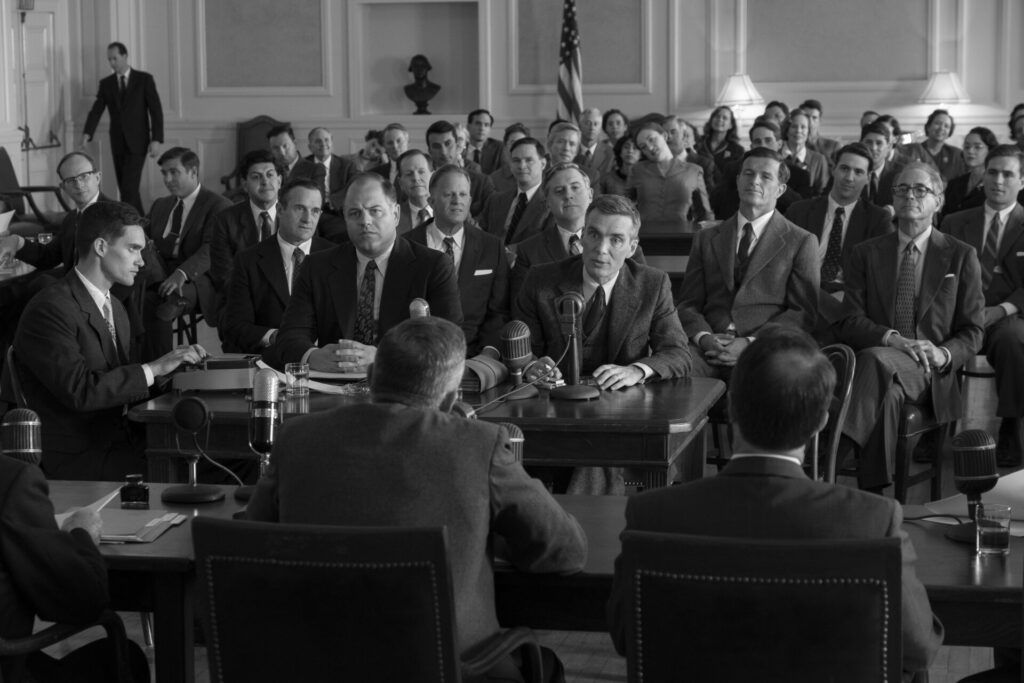 J. Robert Oppenheimer (as portrayed by actor Cillian Murphy) at a 1949 Congressional public hearing on exporting “isotopes” in a scene from Christopher Nolan's film 'Oppenheimer' (Image courtesy of Universal Pictures)
J. Robert Oppenheimer (as portrayed by actor Cillian Murphy) at a 1949 Congressional public hearing on exporting “isotopes” in a scene from Christopher Nolan's film 'Oppenheimer' (Image courtesy of Universal Pictures)
It has been nearly 80 years since the world entered the nuclear age. But the complex story of the making of the first atomic bomb, the decisions US leaders made to use these terrible new weapons on cities, and the post-war policy missteps that opened the door to the dangerous Cold War arms race are all now starting to fade from public consciousness.
The existence of nuclear weapons and the dangers they pose, while well-known and widely feared, are accepted by far too many of those living in one of the world’s nine nuclear-armed countries as part of their “normal” daily lives.
A new survey conducted by the Chicago Council on Global Affairs and Carnegie Corporation of New York finds that nearly two-thirds of Americans believe that “US nuclear weapons have been effective at preventing conflict between the United States and other countries.” At the same time, “a majority of the [American] public is unsure they can assess the benefits or harm of nuclear weapons” but “are at least somewhat interested in learning more about US nuclear weapon policy.”
Christopher Nolan’s mesmerizing, thought-provoking, and sometimes disturbing feature-length film, Oppenheimer, provides a jolting, timely reminder for millions of moviegoers that nuclear weapons are anything but normal because the leaders of a few nations have the power to destroy us all. But it also leaves the viewers with lots of questions unaddressed in the film.
Stunning depiction and some omissions. Over the course of three hours of compelling, visually stunning, expertly crafted cinema, Oppenheimer explores most, but not all, of the key technical, political, and moral data points surrounding the development of nuclear weapons—from the “Gadget” (the nickname for the plutonium-implosion device detonated at Trinity), to questions raised about the morality and necessity of using these new weapons on Japanese cities after the defeat of Germany, the controversy about the post-war development of the “Super” (as the thermonuclear or fusion weapon is often called) to counter the Soviets, and how J. Robert Oppenheimer and his fellow scientists fell victim to the Cold War-era national security apparatus.
Nolan’s script, which is largely based on Kai Bird’s and Martin Sherwin’s masterful 2005 biography American Prometheus, is told from Oppenheimer’s perspective. As such, the film doesn’t directly show the devastation of Hiroshima and Nagasaki. But in perhaps the most emotionally powerful and creative scene in the film, it does make it clear that the chief scientist and other leaders of the Manhattan Project were haunted by knowledge that their invention directly led to the horrific deaths of civilians (which they would later learn had resulted in some 220,000 deaths by the end of 1945).
Not surprisingly, the film bypasses some key storylines relating the bomb’s deadly legacy. These include the lingering health impacts on people downwind from the Trinity blast and subsequent 215 other US atmospheric nuclear tests conducted on US-occupied Marshall Islands in the Pacific and later in Nevada. The film does not mention either the massive health or environmental toll of the sprawling nuclear weapons production complex, all of which were spawned by the Manhattan Project.
But Oppenheimer does succeed in showing how America’s post-war leaders rejected the scientists’ warnings about the long-term dangers of a new race to stockpile atomic weapons and sought short-term advantage over their new Soviet enemy instead.
One can only hope that the film’s eloquent ending scenes will prompt the viewers to think—even long after they leave the theater—about the growing present danger of nuclear arms racing and nuclear war and solutions to move the world away from the brink.
Paths not taken. On the whole, Nolan’s Oppenheimer brings to life the complex, nuanced story of how the “father of the atomic bomb” (as Oppenheimer is often referred to) led its development in order to defeat the Nazis, how he declined to oppose the use of the bomb on Japanese cities as Germany was defeated, and how he finally sought to use his notoriety and access to shape US policy in ways that might reduce the absolute dangers the Manhattan Project he directed had unleashed.
Nolan’s film, however, could have done more to remind viewers of the historical evidence— which is presented in American Prometheus and other historical studies, including Martin Sherwin’s earlier work, A World Destroyed; Hiroshima and Its Legacies—that challenges the official and enduring narrative of the US government that the use of the atomic bombs was necessary to end the war and avoid a massive US invasion of the Japanese homeland that was scheduled for November 1, 1945.
In one scene, Oppenheimer takes us into a meeting of the Interim Committee, the group set up by War Secretary Henry Stimson following Germany’s defeat of May 1945 to directly advise the president and Congress on issues relating to both civilian and military use of nuclear energy. In Nolan’s version, we hear echoes of the arguments being made by many of the Manhattan Project scientists against rushing toward military use on Japanese cities.
Notes of its June 1, 1945 meeting indicate that the Interim Committee dismissed alternative views and agreed that “the final selection of the target was essentially a military decision,” although added “that the bomb should be used against Japan as soon as possible.”
Oppenheimer was aware that most of his fellow scientists favored a technical demonstration test of the bomb on a remote area as a warning shot to the Japanese. Another brief scene in the film depicts a meeting at Los Alamos some time before the Hiroshima and Nagasaki bombing being led by chemist Lilli Hornig, who worked in the explosives division. In the scene we hear the outlines of the scientists’ arguments against the military use of the bomb against Japanese cities.
As documented in American Prometheus (but not mentioned in the film) Hornig would later be one of the 155 Los Alamos scientists who signed a petition urging that the first atom bomb be demonstrated on an uninhabited island as opposed to being dropped on a city without warning.
Despite the many Los Alamos scientists’ opposition, the final recommendation of the Los Alamos Scientific Committee—which included Oppenheimer, Ernest Lawrence, Enrico Fermi, and Arthur Compton—to Stimson weighed in on the side of immediate military use.
Nolan’s film shows how the dissenting views of the scientists were not effectively communicated by the Manhattan Project director to officials in Washington, but it doesn’t show the other ways in which those dissenting views were censored. This was the fate of the Franck Committee report of June 11, 1945, which considered the plan to bomb Japanese cities without warning as “inadvisable” because it would lead to “indiscriminate destruction upon mankind, precipitate the race of armaments, and prejudice the possibility of reaching an international agreement on the future control of such weapons.” When James Franck (a German physicist and Nobel Prize winner on exile at the University of Chicago) went to Washington to deliver the report he had compiled, he was told falsely that Stimson was out of town. The report was then seized by the Army, classified, and never reached the president and his war secretary.
Nolan’s script includes a dramatic, if brief, scene showing how Leo Szilard tried and failed to enlist Oppenheimer in support of the Manhattan Project scientists’ petition against what they viewed as an unnecessary use of the atomic bombs on a nearly defeated Japan. But the now famous Szilard Petition would never be delivered to President Truman and his advisors. The petition made a strong and detailed the case for not using the new weapon until Japan was given another opportunity to surrender. Oppenheimer would fail to endorse or present this argument to Stimson.
Truman’s decision despite alternatives. Several historians, including Martin Sherwin, have uncovered information and documentation that strongly suggest that the United States need not have dropped the first (and even less the second) atomic bomb on Japan to end World War II and that there was time for a technical demonstration test—one that Szilard and his co-signatories proposed—to hasten Japan’s surrender.
Contrary to the enduring myth, US President Harry Truman and his advisors were aware of alternatives to the bombings. They also knew as early as June 1945 that the Japanese government understood the war was lost and was seeking acceptable terms of surrender. Nevertheless, Truman authorized the use of the atomic bombs mainly to enshrine the US postwar geostrategic position vis-à-vis the Soviet Union.
US military commanders and the analysts with the US Strategic Bombing Survey advised Truman, Stimson, and Secretary of State James Byrnes in June 1945 that “by the coordinated impact of blockade and direct [conventional] air attack, Japan could be forced to surrender without invasion.” Unfortunately, none of these historical developments were conveyed in Nolan’s Oppenheimer.
As Sherwin put it in 1987 in the introduction to his book, A World Destroyed, “the choice in the summer of 1945 was not between conventional invasion or a nuclear war. It was a choice between various forms of diplomacy and warfare. While the decision Truman made is understandable, it was not inevitable. It was even avoidable.”
The film vividly conveys Oppenheimer’s increasing concern about the dangers of an unconstrained post-war nuclear arms race with the Soviets. It shows how Truman and Byrnes clung to the naive hope that the Soviets would “never” acquire an atomic bomb on their own and how, in their blindness, they failed to consider what should be done if Moscow rapidly built and tested its own atomic bomb. But the film falls short of showing the scientist’s efforts to advance, in practical terms, a recommendation of the June 1945 Franck Report, which proposed a post-war arrangement to establish some form of international control on the atomic bomb to avert its proliferation and further use in war.
In January 1946, the foreign ministers of the UN Security Council members had agreed to set up a United Nations commission to advise on the destruction of all existing atomic weapons and to work toward using atomic energy for peaceful purposes. Oppenheimer was drafted to serve as the chief scientific US representative at the UN commission. The result, known as the Acheson-Lillienthal report, which was delivered to Truman in March 1946, called for international ownership and operation of all “dangerous” nuclear activities, which covered virtually the entire nuclear fuel cycle. Under the plan, a new international atomic development authority would oversee the development of atomic weapons and managed their associated facilities. This would mean for the United States to essentially relinquish its monopoly on the atomic bomb after the international controls had been established.
Skeptical at that prospect, Byrnes appointed Bernard Baruch to recast and deliver the formal US proposal before the UN commission. What became known as the Baruch Plan proposed to remove the Security Council’s veto power to members in case of violation of international controls and detailed the various “stages” through which such controls would have to evolve before the United States would consider giving up its atomic monopoly. The Soviet Union unsurprisingly opposed to the plan, and this earliest effort to negotiate international controls soon sputtered out completely, “relegating disarmament to, at best, a distant goal,” as disarmament expert Randy Rydell puts it.
Despite these omissions, Nolan’s film does a masterful job of illustrating why Oppenheimer became strongly opposed to the development of the even more powerful hydrogen bombs and Truman’s rejection of such calls for restraint. Of course, Oppenheimer was not the only Manhattan Project scientist who was unwilling to support the development of the hydrogen bomb and who advocated for arms control to avert a dangerous superpower arms race. In May 1946, Albert Einstein announced the formation of the Emergency Committee of Atomic Scientists to educate and mobilize other scientists and the public on the dangers to humanity of the nuclear weapons.
The committee—including many members had been part of the Manhattan Project—declared: “We scientists recognize our inescapable responsibility to carry to our fellow citizens an understanding of the simple facts of atomic energy and its implications for society. In this lies our only security and our only hope. We believe that an informed citizenry will act for life and not for death.” The Emergency Committee helped set off the decades-long, ongoing chain reaction of civil society campaigning to better inform the public debate on nuclear weapons policy and advance effective action on arms control and disarmament.
The future is in our hands. The viewers of Oppenheimer will certainly walk out of theaters with a lot of blind spots. Among them are the consequences of the early failures of US and Soviet leaders to engage in effective dialogue to rein-in the development and stockpiling of ever more powerful and plentiful nuclear stockpiles through the Cold War era.
As American Prometheus notes, in 1965 an interviewer asked Oppenheimer what he thought of Sen. Robert Kennedy’s proposal that President Johnson initiate talks with the Soviet Union to halt the proliferation of nuclear weapons, to which he said: “It’s 20 years too late … it should have been done the day after Trinity.”
Today, we have an even more complex and dangerous array of nuclear risks that might yet, as Nolan warns us at the end of his film, ultimately “set the world on fire.” In 2023, the United States and Russia together still possess roughly 90 percent of the 13,000 nuclear weapons in the world, with each still deploying some 1,500 thermonuclear warheads on strategic missiles and bombers primed to launch within minutes of the go-order.
If a Russian or US leader were to decide to use nuclear weapons first, say in a conflict in Europe, it could potentially quickly escalate to nuclear war, involving a massive exchange of thermonuclear weapons, with hundreds or thousands of detonations occurring within minutes of each other. In such a scenario, tens of millions of people would be killed or injured in the first few hours of the conflict alone.
After a decade of dithering on nuclear arms control and as tensions between today’s major nuclear-armed adversaries grows, we are on the verge of a new era of unconstrained nuclear competition and danger—which some call the second Cold War.
Important bilateral nuclear arms control agreements are now either gone, being ignored, or in jeopardy. Russia’s war on Ukraine has derailed regular US-Russian talks on nuclear risk reduction and arms control. In February 2023, Russia “suspended” the implementation of New START—the only remaining treaty that verifiably limits the world’s two largest nuclear arsenals which is set to expire in early 2026—citing the United States “hostile” attitude but pledged to abide by the central limits of the treaty. Meanwhile, the world’s nuclear-armed nations continue to pour tens of billions of dollars each year to replace and upgrade their deadly arsenals. Those so-called modernization programs can only lead to growing perceived threats which will justify even further spending in an unstoppable spree, which now could become an even more dangerous three-way arms race between the United States, Russia, and China.
Progress on arms control and disarmament is therefore urgent. With sufficient political will and public and international pressure, it is also possible.
For instance, on June 2, President Biden’s National Security Advisor Jake Sullivan declared that the United States is ready to engage in nuclear arms control diplomacy with Russia (as well as with China, France, and the United Kingdom) “without preconditions.” Sullivan suggested that “rather than waiting to resolve all of our bilateral differences, the United States is ready to engage Russia now to manage nuclear risks and develop a post-2026 arms control framework.”
On June 5, Kremlin spokesperson Dmitry Peskov responded that Russia remains open to dialogue with the United States on arms control and described Sullivan’s comments as “important and positive.”
To date, however, the two sides have not yet engaged in discussions about how to restart talks on a post-2026 arms control framework.
Now is the time for the two sides to begin a serious dialogue focused on a new arms control and disarmament. In the absence of such a US-Russia arrangement before New START ends, each side could upload more warheads on their strategic delivery systems quickly, and China might decide to accelerate its ongoing strategic nuclear buildup. Avoiding such a scenario is in the national security interests of all nations.
The negotiation of a complex, bilateral nuclear arms control framework to replace New START would be difficult in good times and extraordinarily difficult so long as Russia’s war on Ukraine continues.
Nevertheless, there is scope for the White House and the Kremlin to reach a unilateral, reciprocal arrangement that neither side will exceed the deployed strategic warhead limit set by New START until a more permanent arms control arrangement comes into effect. This would contribute to a more stable international security environment and improve conditions for overdue progress on multilateral nuclear arms control and disarmament.
According to Sullivan, the Biden administration also supports “new multilateral arms control efforts,” involving all five nuclear-armed members of the UN Security Council. Sullivan proposed that all five countries agree on greater transparency on nuclear doctrines, more effective crisis communications channels, common rules for missile launch notification, and policies to keep “humans in the loop” for command, control, and use of nuclear weapons (in a clear reference to the new risk factor posed by the use of artificial intelligence in those systems).
In addition to these steps, all five countries can and should immediately reaffirm and update a forgotten 1973 US-Soviet agreement on the prevention of nuclear war, which pledges they will “refrain from the threat or use of force against the other party, against the allies of the other party and against other countries, in circumstances which may endanger international peace and security.” It requires that “if at any time there is the risk of a nuclear conflict [each side] shall immediately enter into urgent consultations … to avert this risk.”
Another bold multilateral measure would be for all five nuclear-armed members of the UN Security Council to observe an immediate global nuclear freeze, by which China, France, and the United Kingdom would cap the overall size of their nuclear arsenals and agree to halt fissile material production, so long as Russia and the United States cap their stockpiles and negotiate a new framework to cut their arsenals.
Oppenheimer should remind the public that more nuclear weapons make us all less secure and that we must continue to demand our leaders to pursue the safer path through disarmament diplomacy and toward a world without nuclear weapons before it is too late.
Oppenheimer’s vision for arms control is still upon us
‘Oppenheimer’ is terrific. But it’s just a movie
Thought-provoked by ‘Oppenheimer’
‘Oppenheimer’, the bomb, and arms control, then and now
‘Oppenheimer’ depicts a man becoming powerful—and irrelevant
Nuclear weapons since Oppenheimer: Who’s in control?
What ‘Oppenheimer’ can teach today’s scientists
Nolan’s ‘Oppenheimer’: an artistic visual tapestry of the bomb’s science and power intricacies
Widening the field of view on ‘Oppenheimer’
Together, we make the world safer.
The Bulletin elevates expert voices above the noise. But as an independent nonprofit organization, our operations depend on the support of readers like you. Help us continue to deliver quality journalism that holds leaders accountable. Your support of our work at any level is important. In return, we promise our coverage will be understandable, influential, vigilant, solution-oriented, and fair-minded. Together we can make a difference.
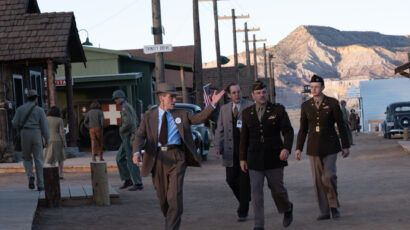

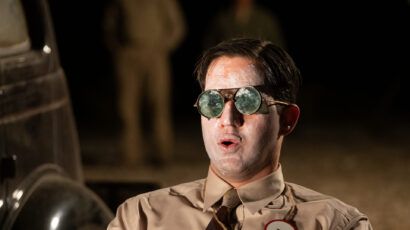
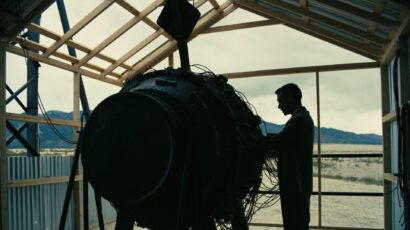
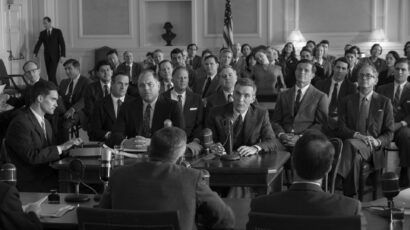
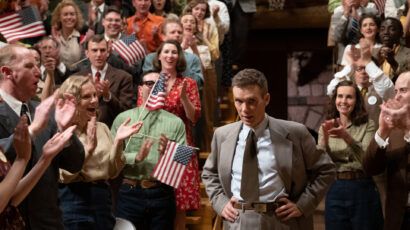
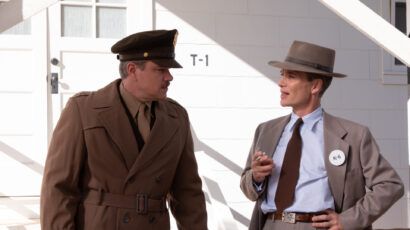

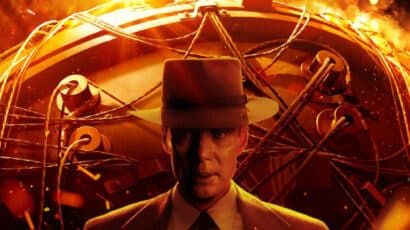

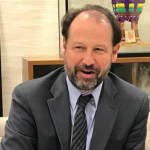

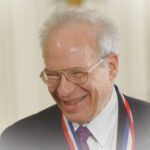
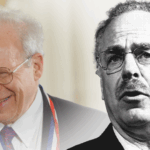
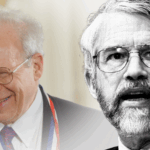
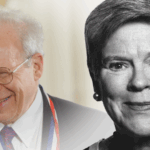
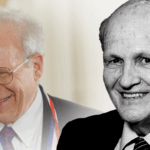
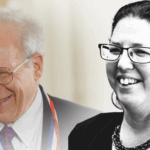
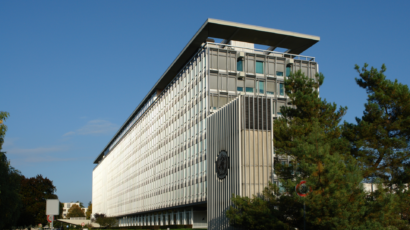
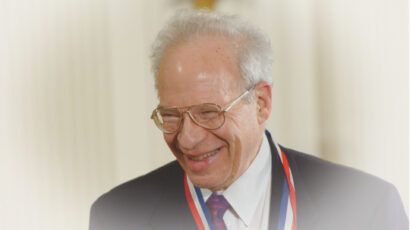
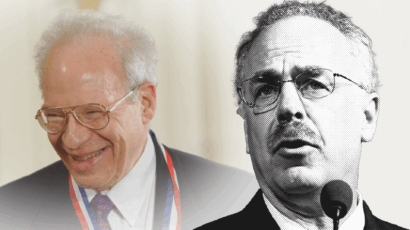
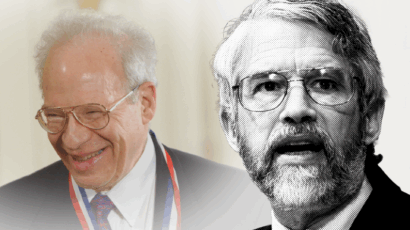
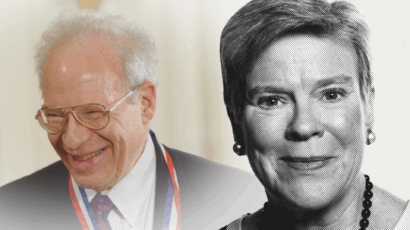
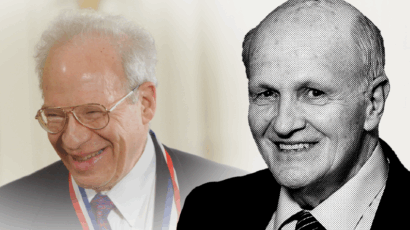
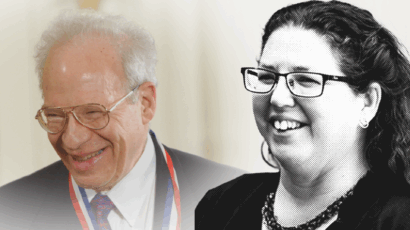
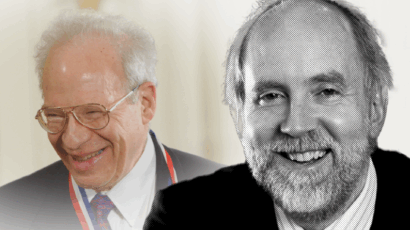
“In January 1946, the foreign ministers of the UN Security Council members had agreed to set up a United Nations commission to advise on the destruction of all existing atomic weapons and to work toward using atomic energy for peaceful purposes.” … “This would mean for the United States to essentially relinquish its monopoly on the atomic bomb after the international controls had been established.” What a ridiculously naive idea! And if we were dumb enough to have actually gone down that route, we would all be speaking Russian now, as the Soviets – who normally did not abide by… Read more »
About Sherwin’s argument that the choice was between diplomacy and warfare, not the conventional weapons and the atomic bomb, I suggest my book, Racing the Enemy (Harvard UP 2005). This book will go into details between the “race” between Truman and Stalin for how to force Japan to surrender. Truman, dropping the bomb to end the war before Soviet entry into the war, and Stalin entered the war before US forced Japan to surrender before the Soviets joined the war.
Prof. Hasegawa, your “Racing the Enemy” book is an important contribution to understanding the considerations that ultimately led to the a-bombings. Thank you and thanks for reading. As I wrote here in the BAS: “Truman authorized the use of the atomic bombs mainly to enshrine the US postwar geostrategic position vis-à-vis the Soviet Union.”
You wrote that 155 Los Alamos scientists, including Lilli Hornig, signed petitions opposing using the atomic bomb on Japan. That’s not correct. Oppenheimer refused to allow Leo Szilard’s petition to be circulated at Los Alamos. The names of all 155 petition signers at Chicago and Oak Ridge have been on my website for almost 30 years.
http://www.dannen.com/decision/
Almost everybody wants to dismantle nuclear weapon arsenals, but where do you start? As has been proposed for nearly four decades [1], the most modest yet meaningful “multilateral measure” to reduce the destructive power of nuclear arsenals is to enact a ban on tritium production. Why tritium? Most modern nuclear weapons depend on neutrons from deuterium-tritium (D-T) fusion reactions to enhance the fission rate in the primary (“boosting”) so that a smaller mass of chemical explosives is needed to reach criticality, and to increase the explosive yield of the primary [2]. Each weapon’s primary contains about 3 grams of tritium. Tritium… Read more »